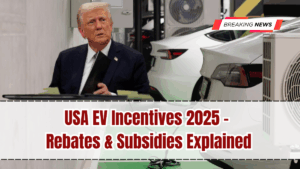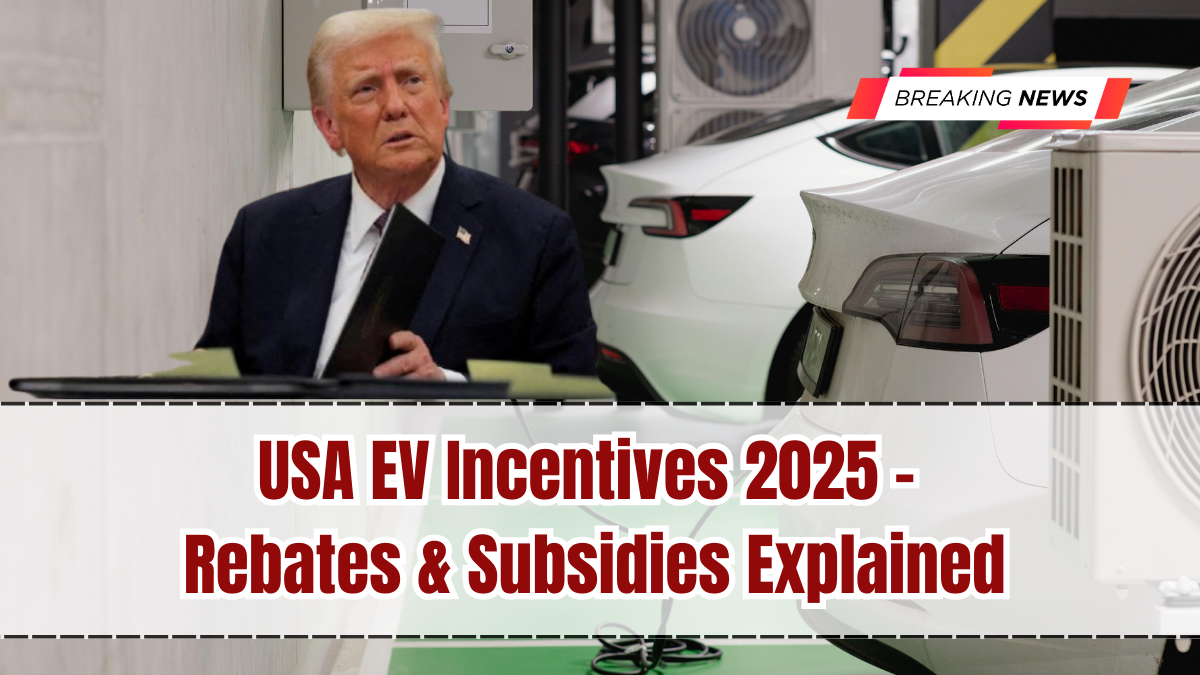Electric vehicles are no longer just a trend in the United States—they are rapidly becoming the future of transportation. In 2025, government programs and private initiatives are making EV ownership more accessible than ever. With rising gas prices and environmental concerns, USA EV Incentives 2025 are designed to help Americans make the switch to clean energy vehicles while saving money.
These incentives range from federal tax credits to state rebates, utility company discounts, and even workplace charging benefits. For buyers considering an electric car this year, understanding available incentives is essential to maximizing savings.

Federal Tax Credits for EV Buyers
The most significant support comes from federal tax credits. In 2025, buyers of eligible electric vehicles can still claim up to $7,500 in credits depending on the model, battery capacity, and assembly location.
To qualify, vehicles must meet manufacturing standards set by the U.S. government, with a strong emphasis on North American production. Plug-in hybrids may also qualify for partial credits. These credits lower the overall purchase cost, making EVs more competitive with gasoline cars.
State-Level Rebates and Subsidies
Beyond federal support, individual states offer their own incentives. California continues to lead, with rebates of up to $2,000 for eligible EV buyers. States like New Jersey and Colorado also provide generous rebates, making EVs attractive in regions where adoption is already strong.
Other states focus on reducing registration fees, offering carpool lane access, or providing exemptions from certain taxes. These localized incentives are an important part of USA EV Incentives 2025, as they encourage adoption based on regional priorities.
Utility Company Programs
Utility companies are playing an increasing role in supporting EV adoption. Many now offer special charging rates during off-peak hours, helping owners save on electricity costs. Some utilities also provide rebates for installing home charging stations, reducing upfront installation expenses.
For example, several providers in Texas and Florida are offering $500 to $1,000 credits for residential charger installations. These programs not only make EV ownership easier but also encourage smarter energy consumption.
Incentives for Businesses and Fleets
Incentives are not limited to private buyers. Businesses switching to electric fleets benefit from tax deductions, grants, and reduced operating costs. Delivery companies, ride-sharing services, and corporate fleets are increasingly adopting EVs to cut fuel expenses and align with sustainability goals.
Government programs in 2025 include fleet-specific rebates and infrastructure grants for businesses installing charging stations. This is helping accelerate nationwide EV adoption across industries.
Charging Infrastructure Development
Incentives also extend to expanding the charging network. Federal funding in 2025 continues to support the construction of thousands of new public charging stations. States are collaborating with private companies to ensure that EV owners can charge conveniently in both urban and rural areas.
This infrastructure expansion reduces “range anxiety” and boosts confidence among potential buyers. The combination of vehicle incentives and charging availability makes 2025 a milestone year for EV growth.
Long-Term Benefits of Incentives
The aim of USA EV Incentives 2025 is not just immediate savings but long-term transformation. Electric vehicles reduce greenhouse gas emissions, improve air quality, and lower dependence on imported oil. They also help consumers save on fuel and maintenance costs over time.
By making EVs financially attractive, these incentives are accelerating the transition to cleaner transportation. The more people switch, the greater the collective benefits for society, including healthier cities and stronger energy independence.
Challenges and Limitations
Despite strong incentives, challenges remain. Some credits are only available for certain models, leaving luxury EVs excluded. Income caps also prevent high-income buyers from accessing federal credits. Additionally, limited charging infrastructure in rural areas slows adoption.
Consumers must carefully review eligibility rules before making a purchase. Missing paperwork or buying a non-qualifying model can result in losing access to valuable incentives. Awareness remains key in making the most of these programs.
The Outlook for EV Incentives
Looking forward, incentives are expected to remain a central part of U.S. energy policy. While some programs may phase out as adoption increases, new incentives for battery recycling, second-hand EVs, and workplace charging are already being discussed.
For now, 2025 offers one of the best opportunities for buyers to take advantage of financial support while making an eco-friendly choice. The combination of federal, state, and private incentives makes electric cars more affordable than ever before.
FAQs
How much is the federal EV tax credit in 2025?
Eligible buyers can receive up to $7,500 in federal tax credits, depending on the vehicle and battery specifications.
Which states have the best EV incentives?
California, Colorado, and New Jersey are among the most generous, offering rebates and additional perks for EV owners.
Do utility companies offer EV charging rebates?
Yes, many utilities provide discounts for installing home chargers and offer reduced rates for off-peak charging.
Are plug-in hybrids eligible for incentives?
Some plug-in hybrids qualify for partial credits, but eligibility depends on battery capacity and assembly requirements.
Will EV incentives continue beyond 2025?
Yes, but they may evolve to include new programs such as incentives for used EVs and battery recycling.
Click here to know more.
